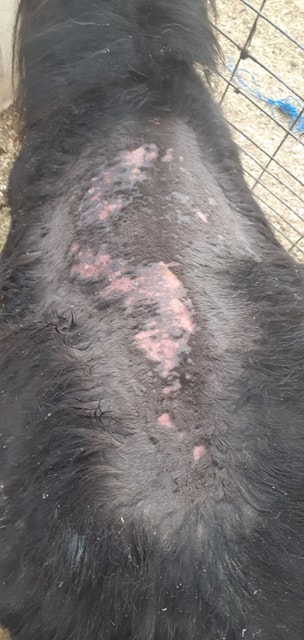It’s so important to put your hands on your Miniature Horses throughout the winter months. Chances are, unless you’re brand new to my website, you’ve seen me talk about this before: you CANNOT accurately determine body condition on a Miniature Horse in full winter coat visually. You have to put their hands on them.
Here’s a video with more on body condition scoring:
While I’ve often cited “skin issues” as another reason to routinely put your hands on your horses to feel through the winter coat, my horses have luckily never had anything too serious going on under their coat. We live in a cold climate, which is actually better for skin – it’s damp weather that’s more likely to cause an environment that predisposes them to icky skin stuff under their thick hair.
But in our 38th Alberta winter caring for Miniature Horses, we found a very icky skin thing hiding under a winter coat.
Oly’s been spending the winter inside, because he injured his shoulder and has been on stall rest. About the time we got the word from the vet that he had healed as much as he is likely to and could go outside again, it got very very cold, and so I decided to keep him in until the weather was better. Which makes the skin thing even more mysterious, as he hasn’t been out in the weather at all.
Last Saturday I let him outside for a bit just while I was cleaning his stall – maybe 20 minutes? – and he rubbed his back on the fence … rubbed it raw. Yucky – it was cold (as per usual lately) so I cleaned it up a bit and put some ointment on it and hoped for the best. By morning, there were icicles of frozen serum down both his sides, and I got some hot water and my clippers and went to work to investigate what was really going on under the wool.
(Tip: If you ever have a wound to treat in very cold weather, a cooler makes a great container for hot water – and keeps it hot!)
Oly’s whole back was covered in weeping sores. They were ouchy in some places, itchy in others, and draining serum steadily. In short, it was super gross and really red and painful looking. I cleaned it up as well as I could, applied Silvadene ointment, and took lots of pictures to consult with my vet.
The vet thought what I was already doing was likely the right approach, we kept at it with daily cleaning, clipping any newly affected areas and then applying Silvadene ointment. At first we bandaged it as well, as it was weeping so much, and then layered on the blankets to keep him warm since I’d now had to clip off his entire back.
Luckily, Silvadene seemed to be the perfect treatment for whatever skin icky has taken hold here, as in just a couple days it stopped weeping, and now, a week later, the first lesions are already beginning to regrow hair, while the newer areas are also improving.


While this isn’t a very likely issue (given this is the very first time we’ve ever seen anything like it!) being aware of the skin health of your horse in the winter is another really good reason to do regular hands-on examinations. Winter hair can hide changes in weight, health, external parasites … and weirdo icky skin things.
Hopefully we start seeing some warmer weather soon, but in the meantime, go touch your horses and make sure they’re weathering the winter well!